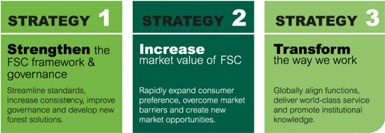We don’t hear much about forest certification these days, but the gold standard – Forest Stewardship Council (FSC) – is still plugging along on bringing environmentally responsible harvesting to the world’s forests.
The group announced a new 5-year strategic plan that has a goal of more than doubling certification by 2020, to 20% of forests.
The emphasis is on increasing FSC certification in tropical countries, and providing voice to those most affected by mismanaged forests – indigenous peoples, workers, communities, women, and smallholders – while delivering stronger results for current certificate holders.

"Entering into our 22nd year we knew we had to be bold in our vision. The demands on forests are only going to increase – possibly tripling by 2050 according to World Wildlife Fund – and FSC needs to take a leading role in shifting the global forest trend toward sustainable use, conservation, restoration, and respect for all," explains Kim Carstensen, FSC Director General.
"There is every indication that the marketplace is prepared to reward responsible forest management on a large scale. Like recycling, that was once only adopted by a committed few, but is now standard practice in millions of businesses and households around the world, so too, we aim for responsible purchasing of forest products to be a simple part of everyday life. We are motivated to bring this opportunity to millions of more people," adds Carstensen.
Unlike the other major certification, Sustainable Forestry Initiative (SFI), which is run by the industry, FSC is a broad-based group that represents all stakeholders and runs by consensus. Founded in 1993, FSC promotes environmentally sound, socially beneficial, and economically prosperous management of the world’s forests.
About 433 million acres and 25,000 companies are currently certified to FSC standards around the world.
Forests & Climate
While some still believe humans can’t impact the climate, scientists are concerned that the massive deforestation still taking place today – especially in South America – has already significantly altered Earth’s climate. Stripping the earth of trees not only releases all their stores of carbon – contributing 11% of world carbon emissions right now – it disrupts the precipitation cycle that could be contributing to the drought as far away as California.
One of the many functions of trees is that they absorb moisture from the soil and release some as water vapor into the air – 20 billion tons a day in the case of the Amazon rainforest. Water vapor creates clouds which can travel long distances – a conveyor belt for rain around the world, reports the NY Times.
The extreme drought Brazil is experiencing is directly connected to deforestation of the Amazon. About 20% is gone and nearly that much is degraded, and last year another 2000 square miles was lost largely to cattle grazing and soybean farms, reports the NY Times. The Amazon itself has been in extreme drought twice over the past decade, releasing as much carbon as the entire US does in a year.
Even in good years, tropical forests are absorbing 11% of world emissions; if they were restored to their original state they would be taking up 24-30%.
"In the broadest sense, scientists say, forests represent a kind of ecological infrastructure that helps maintain comfortable living conditions on the planet, whether by taking up and holding carbon dioxide, cleaning water through their roots, preventing floods by stabilizing soil – or, in this case, by regulating climate," explains the NY Times.
Scientists urge an immediate halt to deforestation, as well as large-scale restoration of forests.
Read our article, Playing Hide & Seek To Stop Deforestation.
FSC Global Strategic Plan 2015-2020:

Please note that your 443 million hectares of FSC certified forests is greatly exaggerated. The total combined certified forests is barely over 300 million hectares which is barely over 10% of the world’s forest. This is the combined certified forests of PEFC and FSC standard. Kind regards,
Bill Adams
The article states that, “Unlike the other major certification, Sustainable Forestry Initiative (SFI), which is run by the industry, FSC is a broad-based group that represents all stakeholders and runs by consensus.” This is a misleading and inaccurate statement and we request that it be removed. The SFI Program has been an independent, multi-stakeholder, non-profit organization since 2007 and is governed by a three-chamber board of directors, representing environmental, economic and social interests equally, so it can meet the many needs of forests and communities. Board members include representatives of diverse organizations, including environmental, conservation, professional and academic groups, independent professional loggers, family forest owners, government officials, labor and the forest products industry. This diversity reflects the variety of interests in the forestry community. Current and past Board members include representatives from The Conservation Fund, Ducks Unlimited Canada, Manomet Center for Conservation Sciences, NatureServe, The Wildlife Society, The Nature Conservancy, and Conservation International. Not only is SFI’s governance structure diverse, the organizations that use our standard is also diverse and includes conservation organizations, community groups, state lands, universities, indigenous peoples, land managers and manufacturers.